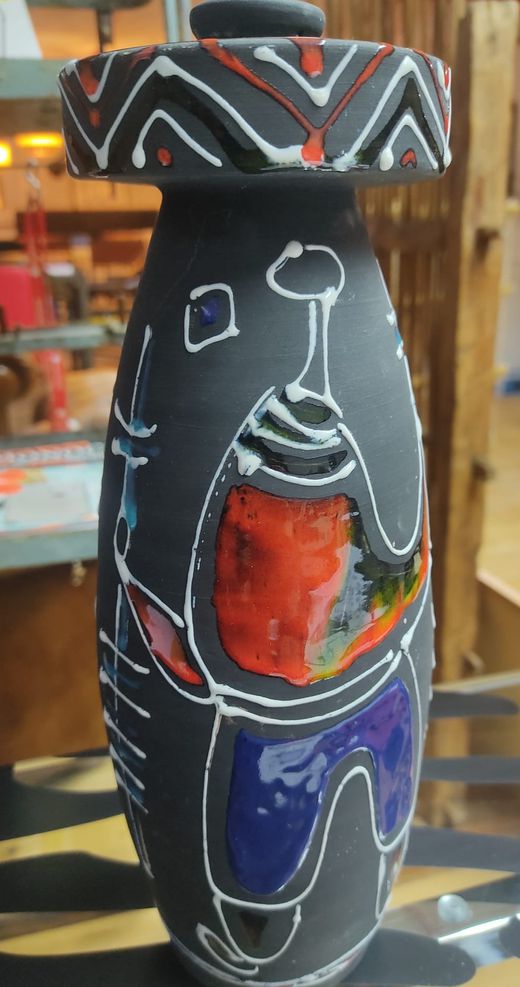

Biography
Although he spent his life in Romagna between Rimini and Faenza, the Lazio accent is still strong, as well as the deep attachment to the land of the Tuscia in the Viterbo area, where Gian Franco Santi, born in 1936, was born and grew up to his youth. The artist and ceramics expert tells us about the human and artistic adventure of his father Luigi Santi, to whom he owes his passion and inclination for the art of ceramics.
Born in 1907, Luigi was of Faentin origin and temperament, as his son emphasizes. He was an "integral ceramist through the choices of his life, his skills and his creativity". Luigi Santi was trained in Faenza at the historic Ballardini Institute, where he was a student of the sculptor Domenico Rambelli.
In 1927 he moved to Civita Castellana to deepen his technique in the ceramic factories there. The whole area was already known for its thriving ceramics production (famous in antiquity for the 4th century BC Falisca pottery, imitated Attic, but also in modern times for decorations such as the "Ticchiolo" motif and the so-called "cloth" technique) and had an unmatched wealth of clays related to the volcanic activity of the area (such as leucitic lavas and red tuff).
In 1931 Santi married Elvira Ciampicacigli, with whom he had three children. After 1947 he founded his own workshop with a dozen employees in Civita in collaboration with Pellegrini.
The return to Romagna was made possible by the project of a ceramics factory in Miramare, supported and promoted by Goffredo Biancoli, who later became his partner and ceramics adviser.
In 1952 the company took the name of Ceramica Riminese In Miramare, in Via Lisbona (a side street off Viale Oliveti), where it is based, specialized workers from different ceramic centers, especially from central Italy, soon became a center of cultural and technical exchange, a point of reference for citizens and tourists, attracted by the artistic and functional value of ceramics.
After years of work and sacrifice, Luigi Santi closed the Miramare workshop in 1961 after many compromises and difficulties. From that moment he moved his business to Cattolica, first in via Nazionale Adriatica in large premises (which today correspond to the large toy shop on the same street) and from the end of 1967 in via Ferrara.
The workshop in Cattolica employed at its peak about 20 workers, potters and decorators, the former coming mainly from the Civita Castellana and Gualdo Tadino area and the latter from Faenza. The production was focused on artistic ceramics, which ensured the maintenance of two retail shops aimed primarily at tourist customers looking for art objects as investments and souvenirs during the summer: one in Piazza 1° Maggio and a second in Gabicce Mare, both managed for a long time (1967-2000) by his daughter Gabriella Santi, who during the years in Rimini had taken care of the logistical aspects and the shipment of Santi ceramics throughout Italy.
Luigi Santi is a creative, light-hearted artist who is as prone to shallowness in his outward relationships as he is perhaps introverted in his more reflective moments. He is a talented and instinctive artist in terms of his strokes and signs and, above all, his inventiveness and skill in working with ceramics. Totally outside of the disputes and relations that raged in Romagna in the 1950s and 1960s on artistic themes between the factions of figurative and abstract artists, Santi embodied the role of artist-craftsman without direct comparison, freely in his workshop.
The opportunity offered today by the willingness of heirs and collectors to exhibit some of the ceramic works and part of the extensive and unpublished body of original drawings certainly represents an important moment in the rediscovery and appreciation of this artist.
Santi's entire career is imbued with spontaneous energy and irony, always feeding his natural dexterity with a curious and bizarre imagination.
Fast drawings with ink, pencil, sometimes with charcoal or watercolors: Santi's signs, which have an irreverent and amusing figurative correspondence, have a very personal touch, they are loose, built on a technique capable of small virtuosities. Since the end of the 1940s he has proved to be a sensitive interpreter of "genre scenes", sketches and figures that characterize his bizarre production: it is the people of the street, the circus, the comedians, pensioners, fishermen, drunkards, acrobats, hunters, the enter lively and burlesque in a repertoire that can also be translated into ceramic decorations, a "small theater" of life without rhetoric but nourished with irony and affection. And a certain melancholy.
Nationality




